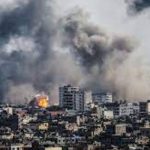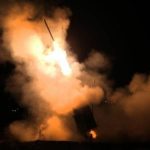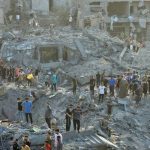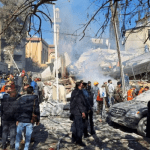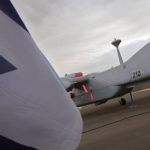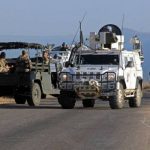Four people, including two journalists, have been killed in Israeli strikes in Lebanon, local media say, as exchanges of fire intensify along the border.
Lebanon’s prime minister condemned the “attack” in the village of Tayr Harfa that killed an Al Mayadeen TV reporter and cameraman along with another man.
An elderly woman was also reportedly killed in Kfarkela, to the east.
The Israeli military has not commented. Earlier, it said aircraft had struck “terrorist cells” in the border area.
It also said they had hit targets belonging to the Lebanese group Hezbollah, which has repeatedly fired missiles and mortar shells across the border since the start of the war between Israel and Hamas in the Gaza Strip six weeks ago.
Al Mayadeen, a Beirut-based Arabic TV channel, said its reporter Farah Omar and cameraman Rabih al-Maamari were “deliberately targeted” as they reported from Tayr Harfa, a village about 2km (1.2 miles) from the border.
A picture posted on social media appeared to show the journalists’ bodies on the ground near a burning TV camera mounted on a tripod.
Lebanon’s state-run National News Agency (NNA) said another civilian, whom it named as Hussein Aqeel, was killed in what would appear to be the third attack on journalists working in southern Lebanon since the start of the war. Al-Mayadeen director Ghassan bin Jiddo said Mr Aqeel was a “contributor”.
A fourth person, who NNA identified as 80-year-old Laiqa Sarhan, was killed and several family members were wounded in a strike on a village further east along the border, the aftermath of which was witnessed by a BBC team.
Their house in Kfarkela was hit and badly damaged. Fire fighters from local civil defence units rushed to the scene to put out the blaze, as ambulances took the wounded family members, including children, to hospital.
Map showing Tayr Harfa and Kfarkela in southern Lebanon
The Israel Defense Forces (IDF) said it was looking into the reports, but it has previously insisted that it does not deliberately target journalists.
Earlier, it put out a statement saying that aircraft had “identified and struck three armed terrorist cells in the area of the border”.
The statement also said mortar shells had been fired towards an IDF post in northern Israel and that artillery struck “the source of the fire” in response.
Hezbollah is an Iran-backed Shia Islamist group that wields considerable military and political power in Lebanon. It is considered a terrorist organisation by Israel, UK, the US and others.
The deadly exchanges along the border escalated after 7 October, when Gaza-based gunmen from Hamas – another Iran-backed group that is also classed as a terrorist group by Israel and Western powers – attacked southern Israel, killing around 1,200 people and taking about 240 others hostage.
Tuesday’s incident in Lebanon comes almost a week after an Israeli attack hit an area in the village of Yaroun where a group of journalists was working.
On 13 October, Israeli strikes killed a Reuters news agency cameraman, Issam Abdallah, and six other journalists were wounded as they reported on clashes near the border.
Lebanon’s public health ministry reports that at least 77 people, including combatants and civilians, have been killed due to armed clashes along the border with Israel, according to the UN.
Israeli authorities say six soldiers and three civilians have been killed in northern Israel over the same period.
Four people, including two journalists, have been killed in Israeli strikes in Lebanon, local media say, as exchanges of fire intensify along the border.
Lebanon’s prime minister condemned the “attack” in the village of Tayr Harfa that killed an Al Mayadeen TV reporter and cameraman along with another man.
An elderly woman was also reportedly killed in Kfarkela, to the east.
The Israeli military has not commented. Earlier, it said aircraft had struck “terrorist cells” in the border area.
It also said they had hit targets belonging to the Lebanese group Hezbollah, which has repeatedly fired missiles and mortar shells across the border since the start of the war between Israel and Hamas in the Gaza Strip six weeks ago.
Al Mayadeen, a Beirut-based Arabic TV channel, said its reporter Farah Omar and cameraman Rabih al-Maamari were “deliberately targeted” as they reported from Tayr Harfa, a village about 2km (1.2 miles) from the border.
A picture posted on social media appeared to show the journalists’ bodies on the ground near a burning TV camera mounted on a tripod.
Lebanon’s state-run National News Agency (NNA) said another civilian, whom it named as Hussein Aqeel, was killed in what would appear to be the third attack on journalists working in southern Lebanon since the start of the war. Al-Mayadeen director Ghassan bin Jiddo said Mr Aqeel was a “contributor”.
A fourth person, who NNA identified as 80-year-old Laiqa Sarhan, was killed and several family members were wounded in a strike on a village further east along the border, the aftermath of which was witnessed by a BBC team.
Their house in Kfarkela was hit and badly damaged. Fire fighters from local civil defence units rushed to the scene to put out the blaze, as ambulances took the wounded family members, including children, to hospital.
Map showing Tayr Harfa and Kfarkela in southern Lebanon
The Israel Defense Forces (IDF) said it was looking into the reports, but it has previously insisted that it does not deliberately target journalists.
Earlier, it put out a statement saying that aircraft had “identified and struck three armed terrorist cells in the area of the border”.
The statement also said mortar shells had been fired towards an IDF post in northern Israel and that artillery struck “the source of the fire” in response.
Hezbollah is an Iran-backed Shia Islamist group that wields considerable military and political power in Lebanon. It is considered a terrorist organisation by Israel, UK, the US and others.
The deadly exchanges along the border escalated after 7 October, when Gaza-based gunmen from Hamas – another Iran-backed group that is also classed as a terrorist group by Israel and Western powers – attacked southern Israel, killing around 1,200 people and taking about 240 others hostage.
Tuesday’s incident in Lebanon comes almost a week after an Israeli attack hit an area in the village of Yaroun where a group of journalists was working.
On 13 October, Israeli strikes killed a Reuters news agency cameraman, Issam Abdallah, and six other journalists were wounded as they reported on clashes near the border.
Lebanon’s public health ministry reports that at least 77 people, including combatants and civilians, have been killed due to armed clashes along the border with Israel, according to the UN.
Israeli authorities say six soldiers and three civilians have been killed in northern Israel over the same period.
Four people, including two journalists, have been killed in Israeli strikes in Lebanon, local media say, as exchanges of fire intensify along the border.
Lebanon’s prime minister condemned the “attack” in the village of Tayr Harfa that killed an Al Mayadeen TV reporter and cameraman along with another man.
An elderly woman was also reportedly killed in Kfarkela, to the east.
The Israeli military has not commented. Earlier, it said aircraft had struck “terrorist cells” in the border area.
It also said they had hit targets belonging to the Lebanese group Hezbollah, which has repeatedly fired missiles and mortar shells across the border since the start of the war between Israel and Hamas in the Gaza Strip six weeks ago.
Al Mayadeen, a Beirut-based Arabic TV channel, said its reporter Farah Omar and cameraman Rabih al-Maamari were “deliberately targeted” as they reported from Tayr Harfa, a village about 2km (1.2 miles) from the border.
A picture posted on social media appeared to show the journalists’ bodies on the ground near a burning TV camera mounted on a tripod.
Lebanon’s state-run National News Agency (NNA) said another civilian, whom it named as Hussein Aqeel, was killed in what would appear to be the third attack on journalists working in southern Lebanon since the start of the war. Al-Mayadeen director Ghassan bin Jiddo said Mr Aqeel was a “contributor”.
A fourth person, who NNA identified as 80-year-old Laiqa Sarhan, was killed and several family members were wounded in a strike on a village further east along the border, the aftermath of which was witnessed by a BBC team.
Their house in Kfarkela was hit and badly damaged. Fire fighters from local civil defence units rushed to the scene to put out the blaze, as ambulances took the wounded family members, including children, to hospital.
Map showing Tayr Harfa and Kfarkela in southern Lebanon
The Israel Defense Forces (IDF) said it was looking into the reports, but it has previously insisted that it does not deliberately target journalists.
Earlier, it put out a statement saying that aircraft had “identified and struck three armed terrorist cells in the area of the border”.
The statement also said mortar shells had been fired towards an IDF post in northern Israel and that artillery struck “the source of the fire” in response.
Hezbollah is an Iran-backed Shia Islamist group that wields considerable military and political power in Lebanon. It is considered a terrorist organisation by Israel, UK, the US and others.
The deadly exchanges along the border escalated after 7 October, when Gaza-based gunmen from Hamas – another Iran-backed group that is also classed as a terrorist group by Israel and Western powers – attacked southern Israel, killing around 1,200 people and taking about 240 others hostage.
Tuesday’s incident in Lebanon comes almost a week after an Israeli attack hit an area in the village of Yaroun where a group of journalists was working.
On 13 October, Israeli strikes killed a Reuters news agency cameraman, Issam Abdallah, and six other journalists were wounded as they reported on clashes near the border.
Lebanon’s public health ministry reports that at least 77 people, including combatants and civilians, have been killed due to armed clashes along the border with Israel, according to the UN.
Israeli authorities say six soldiers and three civilians have been killed in northern Israel over the same period.
Four people, including two journalists, have been killed in Israeli strikes in Lebanon, local media say, as exchanges of fire intensify along the border.
Lebanon’s prime minister condemned the “attack” in the village of Tayr Harfa that killed an Al Mayadeen TV reporter and cameraman along with another man.
An elderly woman was also reportedly killed in Kfarkela, to the east.
The Israeli military has not commented. Earlier, it said aircraft had struck “terrorist cells” in the border area.
It also said they had hit targets belonging to the Lebanese group Hezbollah, which has repeatedly fired missiles and mortar shells across the border since the start of the war between Israel and Hamas in the Gaza Strip six weeks ago.
Al Mayadeen, a Beirut-based Arabic TV channel, said its reporter Farah Omar and cameraman Rabih al-Maamari were “deliberately targeted” as they reported from Tayr Harfa, a village about 2km (1.2 miles) from the border.
A picture posted on social media appeared to show the journalists’ bodies on the ground near a burning TV camera mounted on a tripod.
Lebanon’s state-run National News Agency (NNA) said another civilian, whom it named as Hussein Aqeel, was killed in what would appear to be the third attack on journalists working in southern Lebanon since the start of the war. Al-Mayadeen director Ghassan bin Jiddo said Mr Aqeel was a “contributor”.
A fourth person, who NNA identified as 80-year-old Laiqa Sarhan, was killed and several family members were wounded in a strike on a village further east along the border, the aftermath of which was witnessed by a BBC team.
Their house in Kfarkela was hit and badly damaged. Fire fighters from local civil defence units rushed to the scene to put out the blaze, as ambulances took the wounded family members, including children, to hospital.
Map showing Tayr Harfa and Kfarkela in southern Lebanon
The Israel Defense Forces (IDF) said it was looking into the reports, but it has previously insisted that it does not deliberately target journalists.
Earlier, it put out a statement saying that aircraft had “identified and struck three armed terrorist cells in the area of the border”.
The statement also said mortar shells had been fired towards an IDF post in northern Israel and that artillery struck “the source of the fire” in response.
Hezbollah is an Iran-backed Shia Islamist group that wields considerable military and political power in Lebanon. It is considered a terrorist organisation by Israel, UK, the US and others.
The deadly exchanges along the border escalated after 7 October, when Gaza-based gunmen from Hamas – another Iran-backed group that is also classed as a terrorist group by Israel and Western powers – attacked southern Israel, killing around 1,200 people and taking about 240 others hostage.
Tuesday’s incident in Lebanon comes almost a week after an Israeli attack hit an area in the village of Yaroun where a group of journalists was working.
On 13 October, Israeli strikes killed a Reuters news agency cameraman, Issam Abdallah, and six other journalists were wounded as they reported on clashes near the border.
Lebanon’s public health ministry reports that at least 77 people, including combatants and civilians, have been killed due to armed clashes along the border with Israel, according to the UN.
Israeli authorities say six soldiers and three civilians have been killed in northern Israel over the same period.
Four people, including two journalists, have been killed in Israeli strikes in Lebanon, local media say, as exchanges of fire intensify along the border.
Lebanon’s prime minister condemned the “attack” in the village of Tayr Harfa that killed an Al Mayadeen TV reporter and cameraman along with another man.
An elderly woman was also reportedly killed in Kfarkela, to the east.
The Israeli military has not commented. Earlier, it said aircraft had struck “terrorist cells” in the border area.
It also said they had hit targets belonging to the Lebanese group Hezbollah, which has repeatedly fired missiles and mortar shells across the border since the start of the war between Israel and Hamas in the Gaza Strip six weeks ago.
Al Mayadeen, a Beirut-based Arabic TV channel, said its reporter Farah Omar and cameraman Rabih al-Maamari were “deliberately targeted” as they reported from Tayr Harfa, a village about 2km (1.2 miles) from the border.
A picture posted on social media appeared to show the journalists’ bodies on the ground near a burning TV camera mounted on a tripod.
Lebanon’s state-run National News Agency (NNA) said another civilian, whom it named as Hussein Aqeel, was killed in what would appear to be the third attack on journalists working in southern Lebanon since the start of the war. Al-Mayadeen director Ghassan bin Jiddo said Mr Aqeel was a “contributor”.
A fourth person, who NNA identified as 80-year-old Laiqa Sarhan, was killed and several family members were wounded in a strike on a village further east along the border, the aftermath of which was witnessed by a BBC team.
Their house in Kfarkela was hit and badly damaged. Fire fighters from local civil defence units rushed to the scene to put out the blaze, as ambulances took the wounded family members, including children, to hospital.
Map showing Tayr Harfa and Kfarkela in southern Lebanon
The Israel Defense Forces (IDF) said it was looking into the reports, but it has previously insisted that it does not deliberately target journalists.
Earlier, it put out a statement saying that aircraft had “identified and struck three armed terrorist cells in the area of the border”.
The statement also said mortar shells had been fired towards an IDF post in northern Israel and that artillery struck “the source of the fire” in response.
Hezbollah is an Iran-backed Shia Islamist group that wields considerable military and political power in Lebanon. It is considered a terrorist organisation by Israel, UK, the US and others.
The deadly exchanges along the border escalated after 7 October, when Gaza-based gunmen from Hamas – another Iran-backed group that is also classed as a terrorist group by Israel and Western powers – attacked southern Israel, killing around 1,200 people and taking about 240 others hostage.
Tuesday’s incident in Lebanon comes almost a week after an Israeli attack hit an area in the village of Yaroun where a group of journalists was working.
On 13 October, Israeli strikes killed a Reuters news agency cameraman, Issam Abdallah, and six other journalists were wounded as they reported on clashes near the border.
Lebanon’s public health ministry reports that at least 77 people, including combatants and civilians, have been killed due to armed clashes along the border with Israel, according to the UN.
Israeli authorities say six soldiers and three civilians have been killed in northern Israel over the same period.
Four people, including two journalists, have been killed in Israeli strikes in Lebanon, local media say, as exchanges of fire intensify along the border.
Lebanon’s prime minister condemned the “attack” in the village of Tayr Harfa that killed an Al Mayadeen TV reporter and cameraman along with another man.
An elderly woman was also reportedly killed in Kfarkela, to the east.
The Israeli military has not commented. Earlier, it said aircraft had struck “terrorist cells” in the border area.
It also said they had hit targets belonging to the Lebanese group Hezbollah, which has repeatedly fired missiles and mortar shells across the border since the start of the war between Israel and Hamas in the Gaza Strip six weeks ago.
Al Mayadeen, a Beirut-based Arabic TV channel, said its reporter Farah Omar and cameraman Rabih al-Maamari were “deliberately targeted” as they reported from Tayr Harfa, a village about 2km (1.2 miles) from the border.
A picture posted on social media appeared to show the journalists’ bodies on the ground near a burning TV camera mounted on a tripod.
Lebanon’s state-run National News Agency (NNA) said another civilian, whom it named as Hussein Aqeel, was killed in what would appear to be the third attack on journalists working in southern Lebanon since the start of the war. Al-Mayadeen director Ghassan bin Jiddo said Mr Aqeel was a “contributor”.
A fourth person, who NNA identified as 80-year-old Laiqa Sarhan, was killed and several family members were wounded in a strike on a village further east along the border, the aftermath of which was witnessed by a BBC team.
Their house in Kfarkela was hit and badly damaged. Fire fighters from local civil defence units rushed to the scene to put out the blaze, as ambulances took the wounded family members, including children, to hospital.
Map showing Tayr Harfa and Kfarkela in southern Lebanon
The Israel Defense Forces (IDF) said it was looking into the reports, but it has previously insisted that it does not deliberately target journalists.
Earlier, it put out a statement saying that aircraft had “identified and struck three armed terrorist cells in the area of the border”.
The statement also said mortar shells had been fired towards an IDF post in northern Israel and that artillery struck “the source of the fire” in response.
Hezbollah is an Iran-backed Shia Islamist group that wields considerable military and political power in Lebanon. It is considered a terrorist organisation by Israel, UK, the US and others.
The deadly exchanges along the border escalated after 7 October, when Gaza-based gunmen from Hamas – another Iran-backed group that is also classed as a terrorist group by Israel and Western powers – attacked southern Israel, killing around 1,200 people and taking about 240 others hostage.
Tuesday’s incident in Lebanon comes almost a week after an Israeli attack hit an area in the village of Yaroun where a group of journalists was working.
On 13 October, Israeli strikes killed a Reuters news agency cameraman, Issam Abdallah, and six other journalists were wounded as they reported on clashes near the border.
Lebanon’s public health ministry reports that at least 77 people, including combatants and civilians, have been killed due to armed clashes along the border with Israel, according to the UN.
Israeli authorities say six soldiers and three civilians have been killed in northern Israel over the same period.
Four people, including two journalists, have been killed in Israeli strikes in Lebanon, local media say, as exchanges of fire intensify along the border.
Lebanon’s prime minister condemned the “attack” in the village of Tayr Harfa that killed an Al Mayadeen TV reporter and cameraman along with another man.
An elderly woman was also reportedly killed in Kfarkela, to the east.
The Israeli military has not commented. Earlier, it said aircraft had struck “terrorist cells” in the border area.
It also said they had hit targets belonging to the Lebanese group Hezbollah, which has repeatedly fired missiles and mortar shells across the border since the start of the war between Israel and Hamas in the Gaza Strip six weeks ago.
Al Mayadeen, a Beirut-based Arabic TV channel, said its reporter Farah Omar and cameraman Rabih al-Maamari were “deliberately targeted” as they reported from Tayr Harfa, a village about 2km (1.2 miles) from the border.
A picture posted on social media appeared to show the journalists’ bodies on the ground near a burning TV camera mounted on a tripod.
Lebanon’s state-run National News Agency (NNA) said another civilian, whom it named as Hussein Aqeel, was killed in what would appear to be the third attack on journalists working in southern Lebanon since the start of the war. Al-Mayadeen director Ghassan bin Jiddo said Mr Aqeel was a “contributor”.
A fourth person, who NNA identified as 80-year-old Laiqa Sarhan, was killed and several family members were wounded in a strike on a village further east along the border, the aftermath of which was witnessed by a BBC team.
Their house in Kfarkela was hit and badly damaged. Fire fighters from local civil defence units rushed to the scene to put out the blaze, as ambulances took the wounded family members, including children, to hospital.
Map showing Tayr Harfa and Kfarkela in southern Lebanon
The Israel Defense Forces (IDF) said it was looking into the reports, but it has previously insisted that it does not deliberately target journalists.
Earlier, it put out a statement saying that aircraft had “identified and struck three armed terrorist cells in the area of the border”.
The statement also said mortar shells had been fired towards an IDF post in northern Israel and that artillery struck “the source of the fire” in response.
Hezbollah is an Iran-backed Shia Islamist group that wields considerable military and political power in Lebanon. It is considered a terrorist organisation by Israel, UK, the US and others.
The deadly exchanges along the border escalated after 7 October, when Gaza-based gunmen from Hamas – another Iran-backed group that is also classed as a terrorist group by Israel and Western powers – attacked southern Israel, killing around 1,200 people and taking about 240 others hostage.
Tuesday’s incident in Lebanon comes almost a week after an Israeli attack hit an area in the village of Yaroun where a group of journalists was working.
On 13 October, Israeli strikes killed a Reuters news agency cameraman, Issam Abdallah, and six other journalists were wounded as they reported on clashes near the border.
Lebanon’s public health ministry reports that at least 77 people, including combatants and civilians, have been killed due to armed clashes along the border with Israel, according to the UN.
Israeli authorities say six soldiers and three civilians have been killed in northern Israel over the same period.
Four people, including two journalists, have been killed in Israeli strikes in Lebanon, local media say, as exchanges of fire intensify along the border.
Lebanon’s prime minister condemned the “attack” in the village of Tayr Harfa that killed an Al Mayadeen TV reporter and cameraman along with another man.
An elderly woman was also reportedly killed in Kfarkela, to the east.
The Israeli military has not commented. Earlier, it said aircraft had struck “terrorist cells” in the border area.
It also said they had hit targets belonging to the Lebanese group Hezbollah, which has repeatedly fired missiles and mortar shells across the border since the start of the war between Israel and Hamas in the Gaza Strip six weeks ago.
Al Mayadeen, a Beirut-based Arabic TV channel, said its reporter Farah Omar and cameraman Rabih al-Maamari were “deliberately targeted” as they reported from Tayr Harfa, a village about 2km (1.2 miles) from the border.
A picture posted on social media appeared to show the journalists’ bodies on the ground near a burning TV camera mounted on a tripod.
Lebanon’s state-run National News Agency (NNA) said another civilian, whom it named as Hussein Aqeel, was killed in what would appear to be the third attack on journalists working in southern Lebanon since the start of the war. Al-Mayadeen director Ghassan bin Jiddo said Mr Aqeel was a “contributor”.
A fourth person, who NNA identified as 80-year-old Laiqa Sarhan, was killed and several family members were wounded in a strike on a village further east along the border, the aftermath of which was witnessed by a BBC team.
Their house in Kfarkela was hit and badly damaged. Fire fighters from local civil defence units rushed to the scene to put out the blaze, as ambulances took the wounded family members, including children, to hospital.
Map showing Tayr Harfa and Kfarkela in southern Lebanon
The Israel Defense Forces (IDF) said it was looking into the reports, but it has previously insisted that it does not deliberately target journalists.
Earlier, it put out a statement saying that aircraft had “identified and struck three armed terrorist cells in the area of the border”.
The statement also said mortar shells had been fired towards an IDF post in northern Israel and that artillery struck “the source of the fire” in response.
Hezbollah is an Iran-backed Shia Islamist group that wields considerable military and political power in Lebanon. It is considered a terrorist organisation by Israel, UK, the US and others.
The deadly exchanges along the border escalated after 7 October, when Gaza-based gunmen from Hamas – another Iran-backed group that is also classed as a terrorist group by Israel and Western powers – attacked southern Israel, killing around 1,200 people and taking about 240 others hostage.
Tuesday’s incident in Lebanon comes almost a week after an Israeli attack hit an area in the village of Yaroun where a group of journalists was working.
On 13 October, Israeli strikes killed a Reuters news agency cameraman, Issam Abdallah, and six other journalists were wounded as they reported on clashes near the border.
Lebanon’s public health ministry reports that at least 77 people, including combatants and civilians, have been killed due to armed clashes along the border with Israel, according to the UN.
Israeli authorities say six soldiers and three civilians have been killed in northern Israel over the same period.



